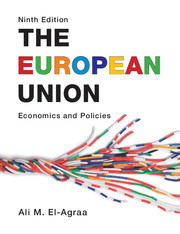Book contents
- Frontmatter
- Contents
- Figures
- Tables
- Boxes
- Contributors
- Preface
- A reader’s guide
- Abbreviations
- 1 General introduction
- Part I EU history, institutions and legal dimension
- 2 A history of European integration and the evolution of the EU
- 3 EU institutions
- 4 The legal dimension in EU integration
- 5 The EU economy
- Part II EU market integration
- Part III EU monetary integration
- Part IV The single European market
- Part V EU budget and structural policies
- Part VI EU external relations
- Part VII The future of the EU
- Bibliography
- Author Index
- Index
5 - The EU economy
bare essentials
from Part I - EU history, institutions and legal dimension
- Frontmatter
- Contents
- Figures
- Tables
- Boxes
- Contributors
- Preface
- A reader’s guide
- Abbreviations
- 1 General introduction
- Part I EU history, institutions and legal dimension
- 2 A history of European integration and the evolution of the EU
- 3 EU institutions
- 4 The legal dimension in EU integration
- 5 The EU economy
- Part II EU market integration
- Part III EU monetary integration
- Part IV The single European market
- Part V EU budget and structural policies
- Part VI EU external relations
- Part VII The future of the EU
- Bibliography
- Author Index
- Index
Summary
The tables referred to in this chapter can be found online at www.cambridge.org/el-agraa
Introduction
This chapter describes the bare realities of the EU economy. The presentation is basically graphic, with the statistical tables on the accompanying website due to space limitations and for ease of regular updating. The graphs and statistics also consider EU immediate candidates, including the member nations of the European Free Trade Association (EFTA), because, apart from Switzerland, they all belong to the European Economic Area (EEA). Recall that the EEA is considered a stepping-stone to full EU membership (see Chapters 1 and 2, where it is also stated that Switzerland has a pending EU membership application). In order to preserve a general sense of perspective, similar information is given where appropriate for Canada, Mexico and the USA (the member nations of the North American Free Trade Agreement, or NAFTA), as well as for Japan and the Russian Federation (Russia), since, together with the four largest EU nations, they comprise the group of eight (G8). Data are also provided for China, due to its rapid ascent in the league of GDI, and for India, which is trying to emulate China and Brazil, because these three together with Russia, form what is referred to as the BRICs, which are becoming increasingly influential in international negotiations, especially in the World Trade Organization (WTO; see Chapters 1 and 24) and the group of twenty (G20).
- Type
- Chapter
- Information
- The European UnionEconomics and Policies, pp. 70 - 78Publisher: Cambridge University PressPrint publication year: 2011



